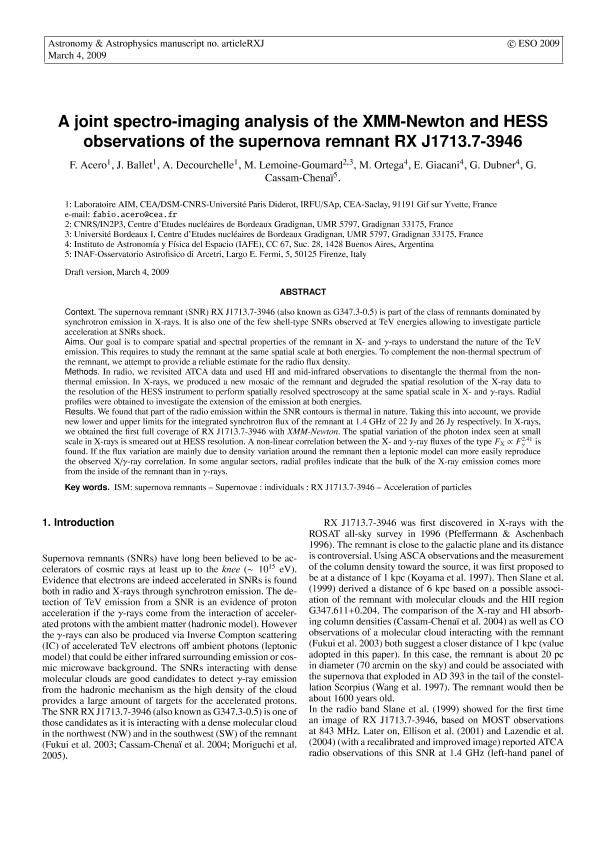Artículo
A joint spectro-imaging analysis of the XMM-Newton and HESS observations of the supernova remnant RX J1713.7-3946
Acero Barriga, Fabio Nelson ; Ballet, J.; Decourchelle, A.; Lemoine Goumard, M.; Ortega, Martin Eduardo
; Ballet, J.; Decourchelle, A.; Lemoine Goumard, M.; Ortega, Martin Eduardo ; Giacani, Elsa Beatriz
; Giacani, Elsa Beatriz ; Dubner, Gloria Mabel
; Dubner, Gloria Mabel ; Cassam Chenai, G.
; Cassam Chenai, G.
 ; Ballet, J.; Decourchelle, A.; Lemoine Goumard, M.; Ortega, Martin Eduardo
; Ballet, J.; Decourchelle, A.; Lemoine Goumard, M.; Ortega, Martin Eduardo ; Giacani, Elsa Beatriz
; Giacani, Elsa Beatriz ; Dubner, Gloria Mabel
; Dubner, Gloria Mabel ; Cassam Chenai, G.
; Cassam Chenai, G.
Fecha de publicación:
12/2008
Editorial:
EDP Sciences
Revista:
Astronomy and Astrophysics
ISSN:
0004-6361
Idioma:
Inglés
Tipo de recurso:
Artículo publicado
Clasificación temática:
Resumen
Context. The supernova remnant (SNR) RX J1713.7-3946 (also known as G347.3-0.5) is part of the class of remnants dominated by synchrotron emission in X-rays. It is also one of the few shell-type SNRs observed at TeV energies allowing to investigate particle acceleration at SNRs shock. Aims. Our goal is to compare spatial and spectral properties of the remnant in X- and -rays to understand the nature of the TeV emission. This requires to study the remnant at the same spatial scale at both energies. To complement the non-thermal spectrum of the remnant, we attempt to provide a reliable estimate for the radio flux density. Methods. In radio, we revisited ATCA data and used HI and mid-infrared observations to disentangle the thermal from the nonthermal emission. In X-rays, we produced a new mosaic of the remnant and degraded the spatial resolution of the X-ray data to the resolution of the HESS instrument to perform spatially resolved spectroscopy at the same spatial scale in X- and gamma-rays. Radial profiles were obtained to investigate the extension of the emission at both energies. Results. We found that part of the radio emission within the SNR contours is thermal in nature. Taking this into account, we provide new lower and upper limits for the integrated synchrotron flux of the remnant at 1.4 GHz of 22 Jy and 26 Jy respectively. In X-rays, we obtained the first full coverage of RX J1713.7-3946 with XMM-Newton. The spatial variation of the photon index seen at small scale in X-rays is smeared out at HESS resolution. A non-linear correlation between the X- and gamma-ray fluxes of the type F_X propto F_gamma^2.41 is found. If the flux variation are mainly due to density variation around the remnant then a leptonic model can more easily reproduce the observed X/ -ray correlation. In some angular sectors, radial profiles indicate that the bulk of the X-ray emission comes more from the inside of the remnant than in gamma-rays.
Archivos asociados
Licencia
Identificadores
Colecciones
Articulos(IAFE)
Articulos de INST.DE ASTRONOMIA Y FISICA DEL ESPACIO(I)
Articulos de INST.DE ASTRONOMIA Y FISICA DEL ESPACIO(I)
Citación
Acero Barriga, Fabio Nelson; Ballet, J.; Decourchelle, A.; Lemoine Goumard, M.; Ortega, Martin Eduardo; et al.; A joint spectro-imaging analysis of the XMM-Newton and HESS observations of the supernova remnant RX J1713.7-3946; EDP Sciences; Astronomy and Astrophysics; 505; 1; 12-2008; 157-167
Compartir
Altmétricas



